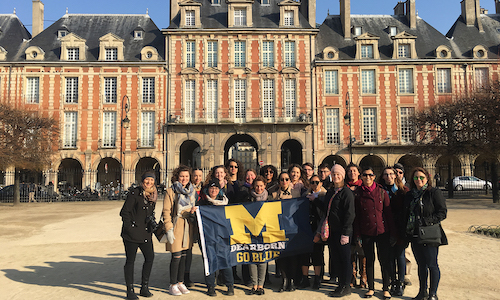
French Studies Professor Gabriella Scarlatta uses photos from important French sites—Notre Dame de Paris, Pont Du Gard Aqueduct, Palace of Versailles—when she teaches her courses. But this semester, she took the visuals to the next level, arranging a trip to France during spring break.
“I’ve been teaching French here for 20 years and I’ve always wanted my students to experience France. It’s one thing to say that the Gardens of Versailles are a work of art. It’s another thing to walk through them,” said Scarlatta, College of Arts, Sciences, and Letters associate dean. “This trip was meant to bring France’s history alive and show how the past is still very much present in French civilization and culture today.”
Scarlatta, French Lecturer Jerilyn Mannion, CASL Dean Marty Hershock, Administrative Director Rita Gordon and 17 students spent eight days traveling France for French 390A: Sites of Memory, which was open to all students.
Giving lessons starting with the Roman conquest into France and working to the French Revolution, the educators found hotel meeting spaces for class time. Typical days would have a lecture in the morning and a class question-and-answer session at night. Between those times, students experienced French life—seeing the past and living in the present.
Students picnicked near the grounds of the Eiffel Tower and perused the art at the Louvre in Paris. They visited the lush Loire Valley and stopped to see Château de Chambord, built for King Francis I. And the group walked across the Pont Du Gard Aqueduct, built circa 50 A.D. in the south of France. They traveled nearly 500 miles, by bus with local tour guides, through the French landscape.
Students earn credit for the course by submitting a paper—written in French for the upper class French students who attended, in English for the others—on a French location they visited and its connection to cultural memory.
Rania Abouzour, a sophomore in the College of Engineering and Computer Science, said she’s writing about Notre Dame de Paris. She said it was inspiring to see the work that people planned and spent their lives trying to build—especially since many of the architects were not able to see their project to completion.
“Today we come up with timelines of months and, in cases of larger projects, a few years. But buildings and structures that we saw in France, like Notre Dame, took more a lifetime,” Abouzour said. “That was someone’s dream and they weren’t able to see it finished; but I was lucky enough to.”
Abouzour—who has decided to minor in French—said regardless of your major or career path, knowing another language and having familiarity with another culture will open doors.
“With engineering being a global profession, it’s important to learn other languages and have exposure to how people may do things differently or better,” said Abouzour, whose interest in speaking French started as a teenager when her family planned a trip to Quebec, Canada. “For example, the civil engineers in Paris are among the best. They keep the city thriving by figuring out how to add modern systems like metro transit, while keeping the historic structures stable. It was impressive to see how they merged the new with the old city infrastructure.”
Abouzour had never been outside of North America prior to this trip. But she now plans to continue to seek out travel and study abroad opportunities.
Scarlatta said the campus was very supportive of the international experience. For example, the CASL dean’s office and the Hub for Teaching and Learning contributed to offset travel costs, and many across campus supported class fundraising efforts.
Since returning, more students have expressed an interest in the course. So Scarlatta is looking into making French 390A: Sites of Memory a regularly scheduled course every other year.
Scarlatta said even with all of the scenery, monuments and architecture in France, her favorite part of the experience was her students.
“They were so engaged, and seeing them make connections to French culture and history was a trip highlight for me,” she said. “Now when our students think about things that once seemed so remote, through either time or distance—like a monument built by Romans or castles built by kings—they will have a connection to it.”



